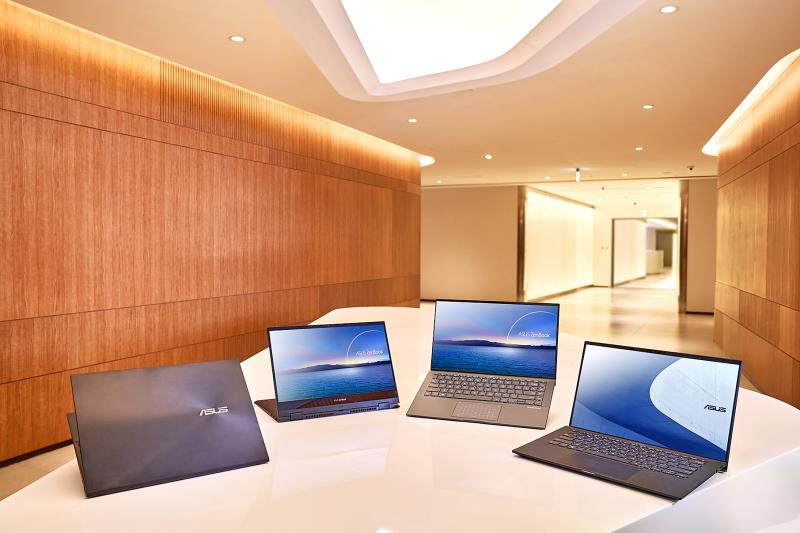Asustek Computer Inc (華碩) on Friday said it made NT$3.739 billion (US$129.3 million) in unaudited standalone net profit last month, up 62 percent from a year earlier.
The unaudited profit for Asustek’s brand-name business translated into earnings per share of NT$5.04, the company said in a regulatory filing.
The firm also reported unaudited standalone revenue of NT$36.586 billion, up 34.57 percent annually.

Photo courtesy of Asustek Computer Inc
The PC vendor released the monthly results at the request of the Taiwan Stock Exchange, as its shares were classified as “attention securities” by the exchange regulator due to the abnormal trading volume of the stock in the most recent six business days, the exchange said.
Based on the firm’s data, third-quarter brand-name revenue reached NT$118.61 billion, up 41.05 percent from the previous quarter and up 37.78 percent from a year earlier due to demand created by the remote work and learning trends amid the COVID-19 pandemic.
Asustek has been among the biggest beneficiaries of the increase in people staying at home due to the pandemic, which has boosted its sales of consumer and commercial PCs.
The firm’s shipments were also boosted by a steady increase in gaming demand as the pandemic has dragged on, analysts said.
The company had earlier said that it remained cautiously positive regarding its outlook for next year.
Asustek forecast that its diverse product offerings across the consumer, commercial, education and gaming sectors would make it a key beneficiary of the new norms in the post-COVID era.
Credit Suisse Group AG analysts said in a note last week that Asustek’s sales for this quarter would be supported by an increase in new laptop and graphics card ranges, as well as the restocking of inventory at distribution channels.
However, tightness with regards to key components would continue to drag on further increases in sales, they said.
“We believe the PC demand will remain more resilient into year-end with Asustek as key beneficiary on higher consumer mix; however, we remain cautious on the sustainability of the demand uptick, and will continue to monitor its smartphone strategy for turnaround,” the analysts wrote.
Asustek shares ended 0.41 percent higher at NT$242.5 in Taipei trading on Friday. They have risen 4.75 percent from the beginning of this year.

Taiwan Semiconductor Manufacturing Co (TSMC, 台積電) last week recorded an increase in the number of shareholders to the highest in almost eight months, despite its share price falling 3.38 percent from the previous week, Taiwan Stock Exchange data released on Saturday showed. As of Friday, TSMC had 1.88 million shareholders, the most since the week of April 25 and an increase of 31,870 from the previous week, the data showed. The number of shareholders jumped despite a drop of NT$50 (US$1.59), or 3.38 percent, in TSMC’s share price from a week earlier to NT$1,430, as investors took profits from their earlier gains

In a high-security Shenzhen laboratory, Chinese scientists have built what Washington has spent years trying to prevent: a prototype of a machine capable of producing the cutting-edge semiconductor chips that power artificial intelligence (AI), smartphones and weapons central to Western military dominance, Reuters has learned. Completed early this year and undergoing testing, the prototype fills nearly an entire factory floor. It was built by a team of former engineers from Dutch semiconductor giant ASML who reverse-engineered the company’s extreme ultraviolet lithography (EUV) machines, according to two people with knowledge of the project. EUV machines sit at the heart of a technological Cold

Taiwan’s long-term economic competitiveness will hinge not only on national champions like Taiwan Semiconductor Manufacturing Co. (TSMC, 台積電) but also on the widespread adoption of artificial intelligence (AI) and other emerging technologies, a US-based scholar has said. At a lecture in Taipei on Tuesday, Jeffrey Ding, assistant professor of political science at the George Washington University and author of "Technology and the Rise of Great Powers," argued that historical experience shows that general-purpose technologies (GPTs) — such as electricity, computers and now AI — shape long-term economic advantages through their diffusion across the broader economy. "What really matters is not who pioneers

TAIWAN VALUE CHAIN: Foxtron is to fully own Luxgen following the transaction and it plans to launch a new electric model, the Foxtron Bria, in Taiwan next year Yulon Motor Co (裕隆汽車) yesterday said that its board of directors approved the disposal of its electric vehicle (EV) unit, Luxgen Motor Co (納智捷汽車), to Foxtron Vehicle Technologies Co (鴻華先進) for NT$787.6 million (US$24.98 million). Foxtron, a half-half joint venture between Yulon affiliate Hua-Chuang Automobile Information Technical Center Co (華創車電) and Hon Hai Precision Industry Co (鴻海精密), expects to wrap up the deal in the first quarter of next year. Foxtron would fully own Luxgen following the transaction, including five car distributing companies, outlets and all employees. The deal is subject to the approval of the Fair Trade Commission, Foxtron said. “Foxtron will be